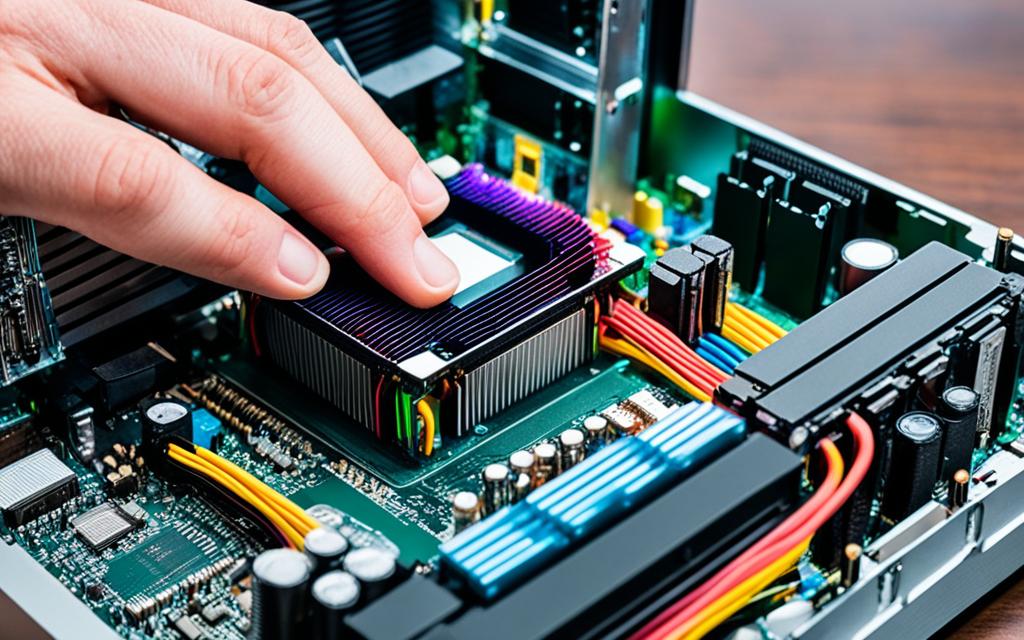Table of Contents
Keeping an eye on the CPU fan speed is key for top computer function and cooling. Often, computers overheat when they’re running games or editing videos. This makes watching and adjusting fan speeds very important1. By knowing how to check and control these speeds, you can stop overheating and save your computer from damage. There are ways to do this, like changing BIOS settings or using special software. This helps your hardware last longer and makes your computing better.
Key Takeaways
- Monitoring CPU fan speed is vital to prevent overheating issues that frequently occur during intensive tasks.
- Software tools like SpeedFan and HWMonitor provide real-time readings to assist in effective fan control.
- Accessing BIOS settings offers detailed insights into fan speed adjustments and overall system performance.
- Regular maintenance checks help ensure optimal performance and prevent hardware failures.
- Effective monitoring can significantly extend the lifespan of your CPU and other components.
Understanding CPU Fan Types
CPU fans are essential for keeping computers cool. They come in Molex, DC, and PWM types. Each type works differently and suits various computing needs.
Different Fan Connectors
Fan connectors link the fan to the computer. They come in three types:
- Molex Connectors: These have four pins and plug into the PSU. They don’t allow for speed control.
- DC Fans: These have three pins and let you change the speed through voltage adjustments. However, they’re not as efficient as PWM fans.
- PWM Fans: With four pins, PWM fans can adjust their speed automatically. This makes them very efficient for cooling.
The Importance of Fan Types
Different CPU fans impact a computer’s heat and noise. Larger fans, for example, can be quieter as they spin slower, usually between 700 to 1,500 RPM. This is key for better cooling with less noise.
It’s vital to monitor fan speeds and CPU temps for proper heat management2. Molex fans provide constant power without speed control. PWM fans, on the other hand, adjust their cooling based on the CPU’s heat3. Choosing the right fan ensures your device runs well for longer.
Utilising BIOS for Fan Speed Control
Learning how to manage BIOS fan control is key for keeping your computer cool. You can enter the BIOS when you start up by pressing a certain key. Once you’re in, you’ll find options to adjust the CPU fan speed, which allows you to customise cooling.
Accessing BIOS Settings
To get into the BIOS settings, restart your machine and hit the key shown on the screen. Look for the “Hardware” or “PC Health” menu. Here, over 90% of today’s motherboards let you tweak fan speeds. You can choose fan types like DC or PWM and set them to Full Speed, Silent, or Performance4. Learning to use these settings can drop noise levels and make your coolers work better5.
Adjusting Fan Settings
It’s crucial to set when fans kick in to keep CPU temps ideal. During heavy computer use, setting temperature-triggered fan speeds is wise. BIOS options offer ways to create custom fan curves6. Keeping your computer clean from dust is also important. Up to 75% of tech experts suggest cleaning every three months for the best airflow4.
For more tips on fan speed management and computer upkeep, see this guide on optimising fan settings. There’s also a guide on how to adjust fan speeds on your PC.
How to Monitor CPU Fan Speed Using Software
Today, it’s critical to have CPU fan monitoring software handy. This software ensures your computer’s performance stays top-notch and your system lasts longer. It works by watching your fan speeds closely. This helps keep your hardware safe by making sure it doesn’t get too hot.
Popular Software Options
Users favour several applications for watching over fan speeds and temperatures. Here are ones people like a lot:
- HWMonitor: It shows you a bunch of sensors and system stats.
- SpeedFan: Loved for letting users change fan speeds easily and for its detailed temperature info. It’s a favourite for Speedfan usage7.
- MSI Afterburner: Mostly helps keep an eye on your GPU but has tools for managing your CPU fan too.
- NZXT CAM: Easy to use, letting you control and monitor fans without a fuss.
Getting Started with Speedfan
Speedfan stands out in fan control applications for its ability to adjust fan speeds well. Getting it set up is easy. Just download it from its website and follow the instructions to install. After you install it, some initial steps get Speedfan ready for use. Users should:
- Open the program so it can find your computer parts.
- Look at the temperatures it shows. Make sure your CPU stays below 70 degrees for the best running8.
- Change the fan speeds to fit how you need your computer cooled. Just be careful not to make them too slow, or your computer could get too hot.
In the ‘Configure’ menu, you can fine-tune settings. You can pick fan modes and set limits. Doing this makes sure your fans work just right, boosting your computer’s performance.
Advanced Monitoring Techniques
In the world of tech, centralised network monitoring is key for businesses to boost their network monitoring CPU use. Using top tools like Zabbix and 10-Strike Network Monitor Pro, they can watch many systems all at once. This makes sure things run smoothly. These tools track how well things work and help stop problems before they start.
Centralised Network Monitoring
Centralised network monitoring gathers data from lots of devices. This gives a full picture of how systems are doing. It’s great for keeping an eye on CPU fan speeds to stop overheating. With devices like the ADM1029 Dual PWM Fan Controller, businesses can keep systems cool. This makes their hardware last longer9.
Setting Alerts and Thresholds
Setting up alerts for CPU temperature stops overheating and keeps fans working right. By setting limits on fan speeds and temperatures, admins can stop damage before it happens. SpeedFan is great for checking temperatures and finding airflow problems10. With these tools, businesses can save energy and run more smoothly.
| Monitoring Tools | Features | Support |
|---|---|---|
| Core Temp | Real-time temperature display, supports various processors | Intel, AMD, VIA |
| HWiNFO32 | Extensive hardware information and real-time monitoring | Windows, DOS |
| SpeedFan | Access voltages, temperature reports, unique online analysis | Windows 9x – Windows Server 2012 |
| Argus Monitor | Fan control based on multiple temperature sources | ITE, Winbond, Fintek, Nuvoton, SMSC |
Using enterprise monitoring tools is crucial for managing heat in today’s computer systems. Smart alerts keep things running well and ensure systems last longer.
Monitoring fan speeds and temperatures enhances computing and helps avoid hardware issues11.
Conclusion
In the world of keeping computers running smoothly, watching over your CPU fan is key. Knowing about the different types of fans and how to connect them is crucial. You can use tools in the BIOS or software from other companies to make sure your fan is doing its job.
It’s very important to regularly check the fan’s RPM with a12. This stops the computer from getting too hot. Overheating can slow down the CPU when you’re doing heavy tasks and can also cause long-term damage.
Generally, a CPU can work well up to 90 degrees Celsius. But it’s better to keep it under 80 degrees Celsius for the best performance and life span13. Using good cooling systems and monitoring apps like SpeedFan or HWMonitor helps a lot. They let you adjust the fan based on how the temperature changes and the computer’s demands14. This way, you protect your CPU and make sure it can always work at its best.
To get the most out of your CPU fan, mix hardware and software solutions. Adjust your fan to meet your computer’s needs. Paying close attention to your fan is a smart move. It ensures your computer runs reliably and at top speed.
FAQ
What is the significance of monitoring CPU fan speed?
Keeping an eye on CPU fan speed is vital. It keeps the computer running smoothly and avoids overheating. This way, the hardware lasts longer and remains stable, even when working hard.
How can I access and adjust CPU fan settings in BIOS?
To adjust CPU fan settings, start by entering the BIOS when your computer boots. Look for the hardware monitoring section. Here, you can pick the fan type and how it operates. You can also set when the fan should kick in based on temperature.
What types of CPU fan connectors are there?
CPU fans connect in three main ways: Molex, 3-pin, and 4-pin. Molex connectors power the fan without controlling speed. 3-pin connectors adjust speed through voltage changes. The 4-pin ones offer the best control over fan speed, adjusting as needed.
What software can I use for monitoring CPU fan speed?
For monitoring CPU fan speed, try Speedfan, CoreTemp, or Open Hardware Monitor. These provide current data on temperatures and fan speeds. With them, you can keep your cooling system in check.
How does Speedfan enhance CPU fan control?
Speedfan lets you keep tabs on temperatures and control fan speeds automatically. Setting it up right means your CPU fan adjusts to what your system is doing. This prevents overheating and keeps everything running smoothly.
What is centralised network monitoring for CPU fans?
With tools like Zabbix and 10-Strike Network Monitor Pro, you can watch over many systems at once. These tools alert you if temperatures or fan speeds hit worrying levels. It’s a smart way to stop overheating problems quickly.
How can effective CPU fan monitoring enhance overall system performance?
Good CPU fan monitoring is key to keeping your system at its best. With the right tools, your computer stays cool. This is important for dependable performance, especially when running intense programs.
Source Links
- https://softwareg.com.au/blogs/computer-hardware/how-to-check-cpu-fan-speed – How To Check CPU Fan Speed
- https://www.auslogics.com/en/articles/quick-tips-how-to-control-cpu-fan-speed-on-windows-pcs/ – Quick Tips: How to Control CPU Fan Speed on Windows PCs
- https://www.linkedin.com/advice/0/how-do-you-choose-right-fan-speed-processor-cooling-3dutc – How do you choose the right fan speed for processor cooling?
- https://medium.com/@prasannaeh8/how-to-control-cpu-fan-speed-a-comprehensive-guide-9079770bfeb4 – How to Control CPU Fan Speed: A Comprehensive Guide
- https://softwareg.com.au/blogs/computer-hardware/change-cpu-fan-speed-in-bios – Change CPU Fan Speed In Bios
- https://ms.codes/blogs/computer-hardware/how-to-control-cpu-fan-speed – How To Control CPU Fan Speed
- https://www.linkedin.com/advice/3/what-best-tools-methods-monitor-control-your-fan-speeds – What are the best tools and methods to monitor and control your fan speeds and temperatures?
- https://www.lifewire.com/control-cpu-fan-on-windows-10-4776311 – How to Control the CPU Fan on Windows 10
- https://www.geeksforgeeks.org/best-cpu-temperature-monitoring-tools/ – 10 Best CPU Temperature Monitoring Tools in 2024
- https://www.almico.com/speedfan.php – Access temperature sensor in your computer
- https://www.argusmonitor.com/how_to_control_system_cpu_and_gpu_fans_by_temperature.php?language=en – Fan Control based on all temperatures of your PC made easy
- https://softwareg.com.au/blogs/computer-hardware/how-to-check-cpu-fan-rpm – How To Check CPU Fan RPM
- https://softwareg.com.au/blogs/computer-hardware/how-to-monitor-cpu-temp-and-fan-speed – How To Monitor CPU Temp And Fan Speed
- https://softwarekeep.com/blogs/how-to/control-fan-speed-on-windows – How To Control Fan Speed on Windows Computers








